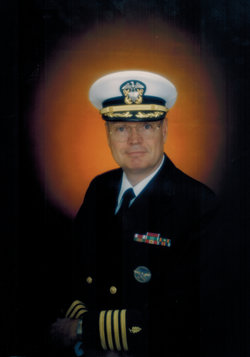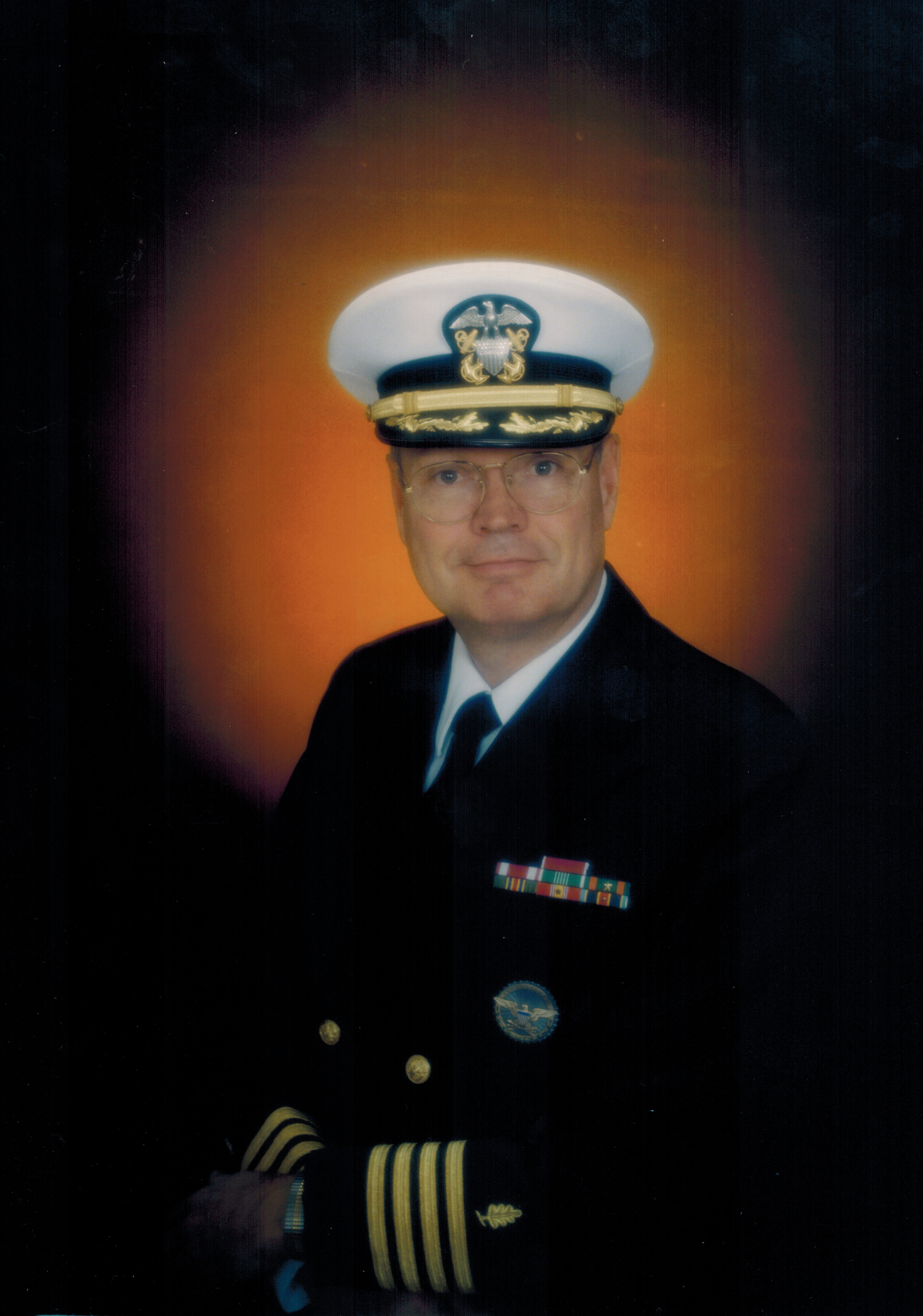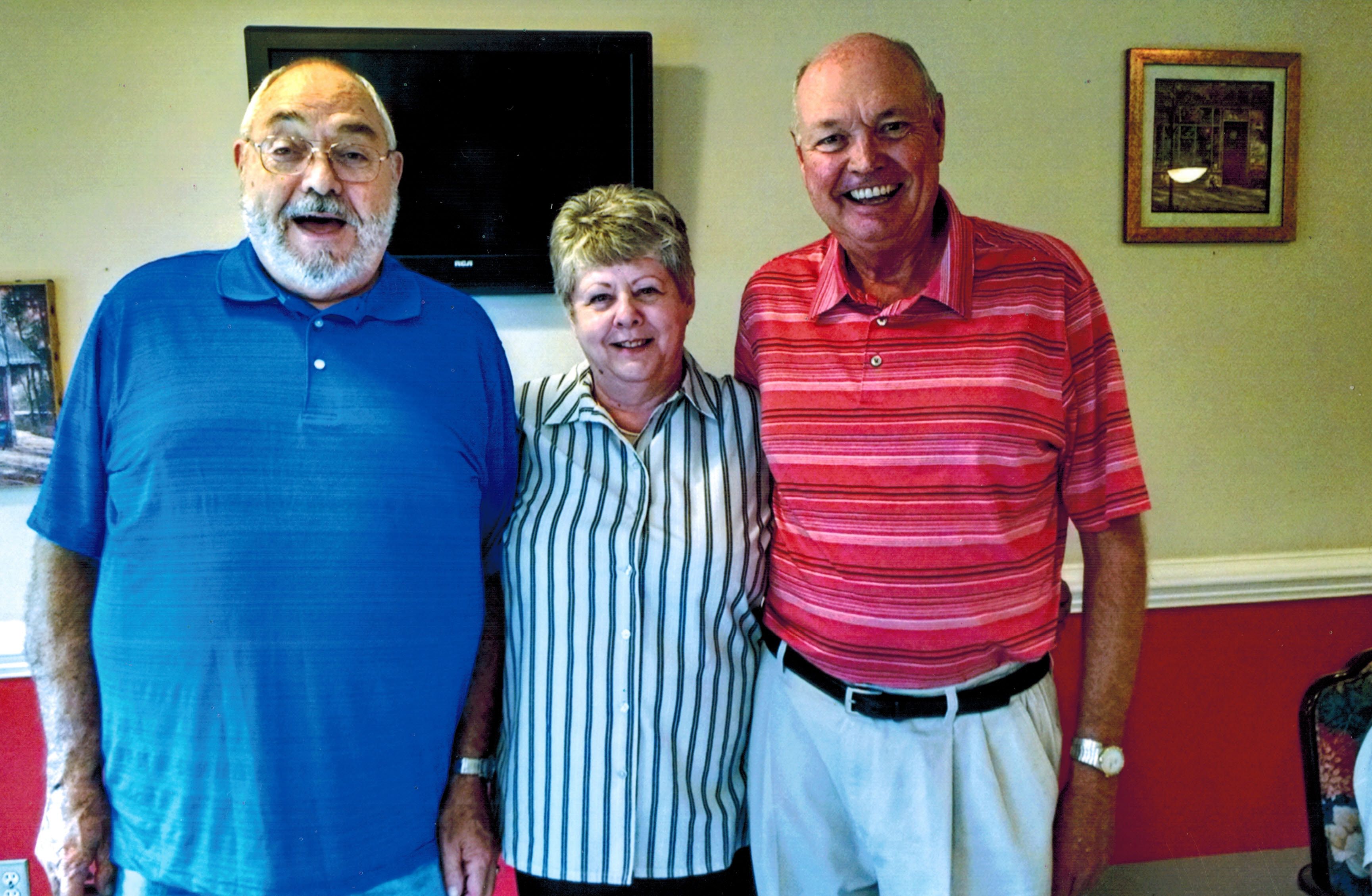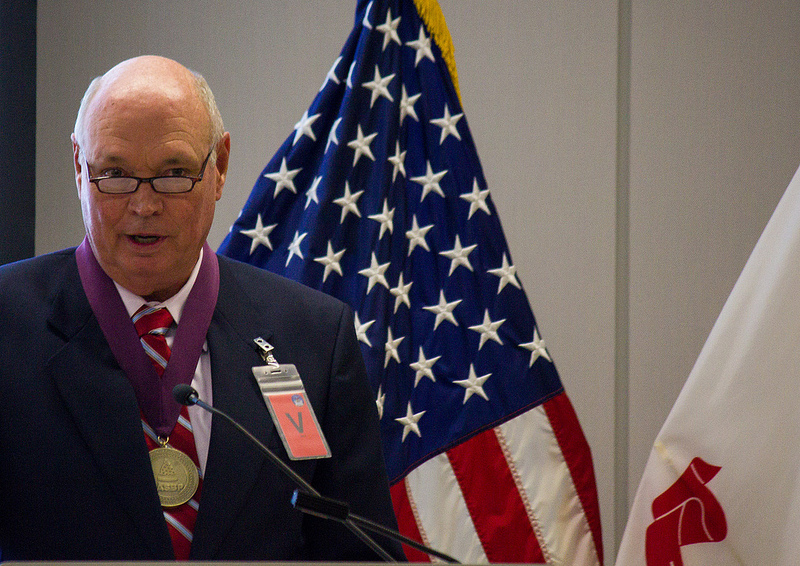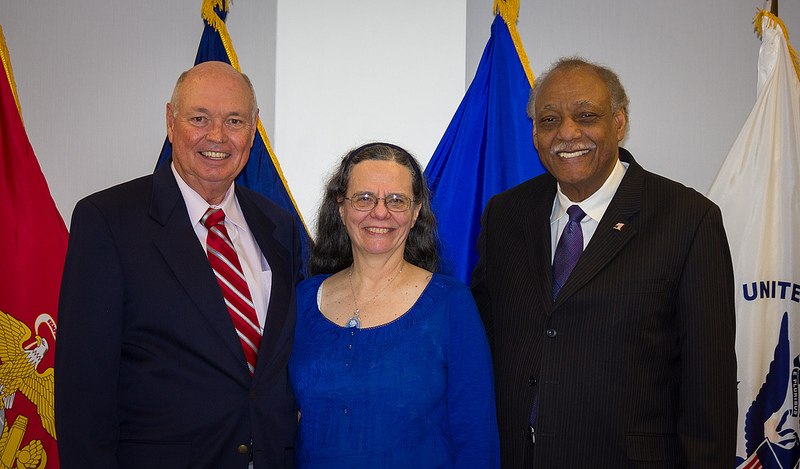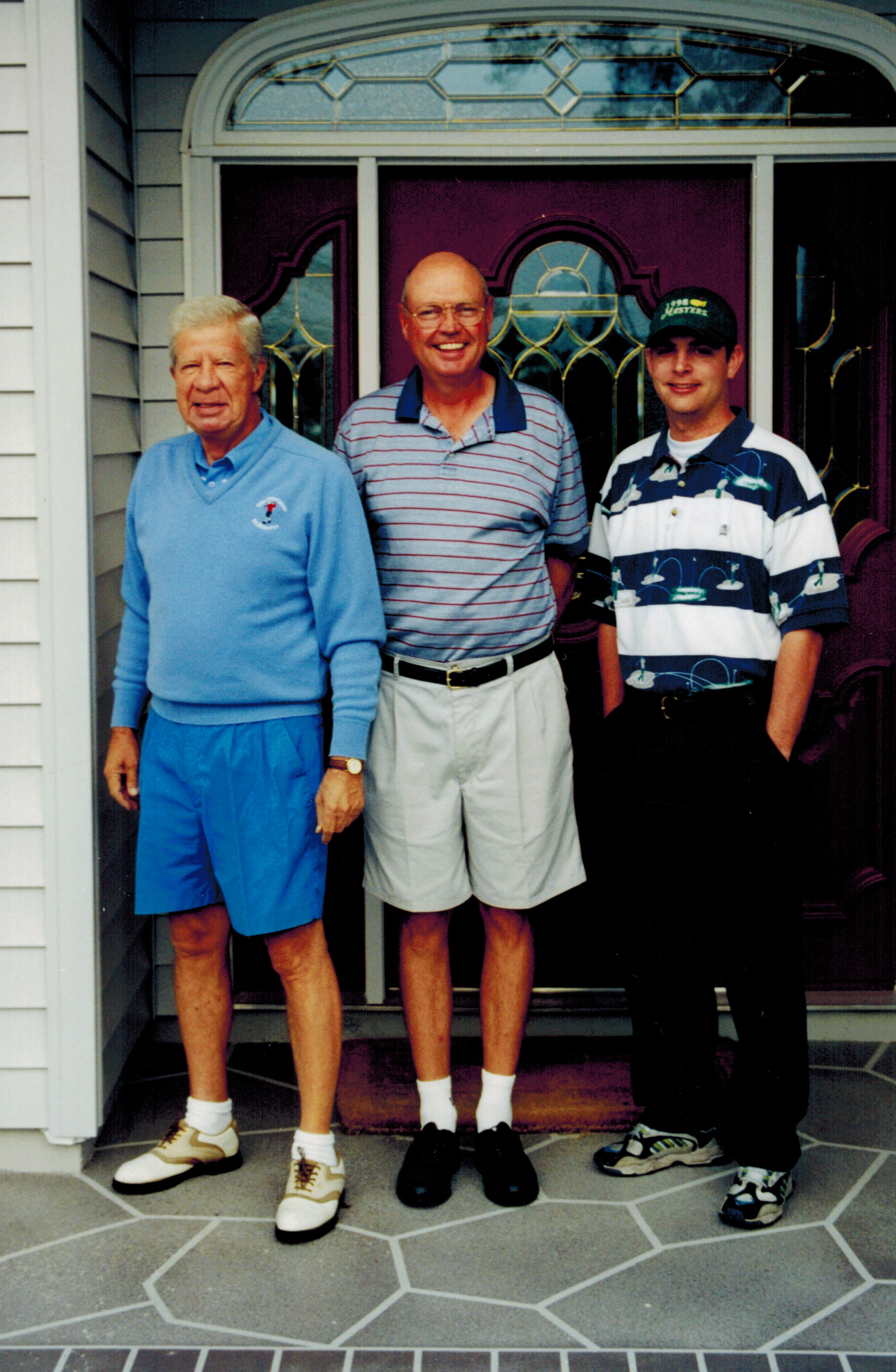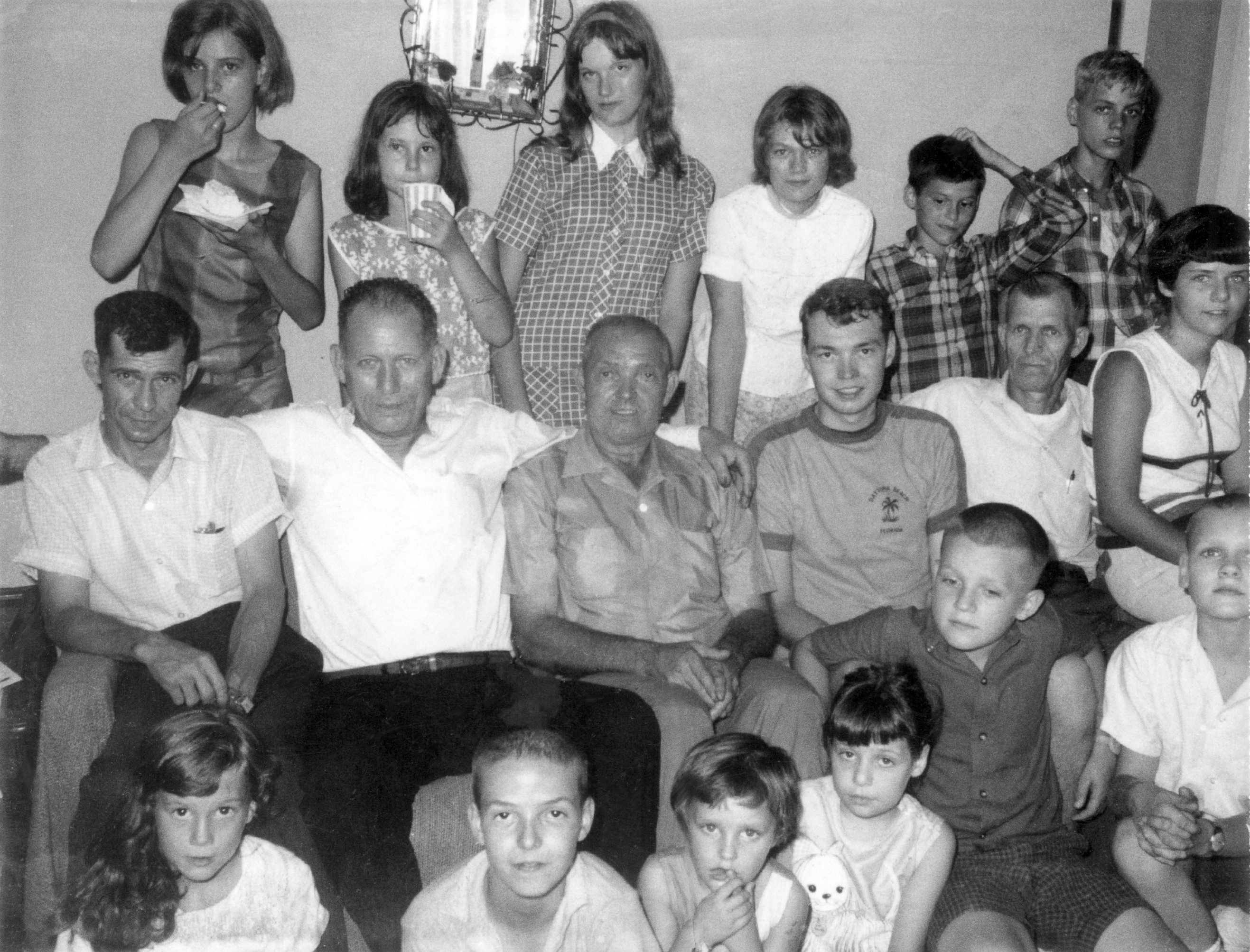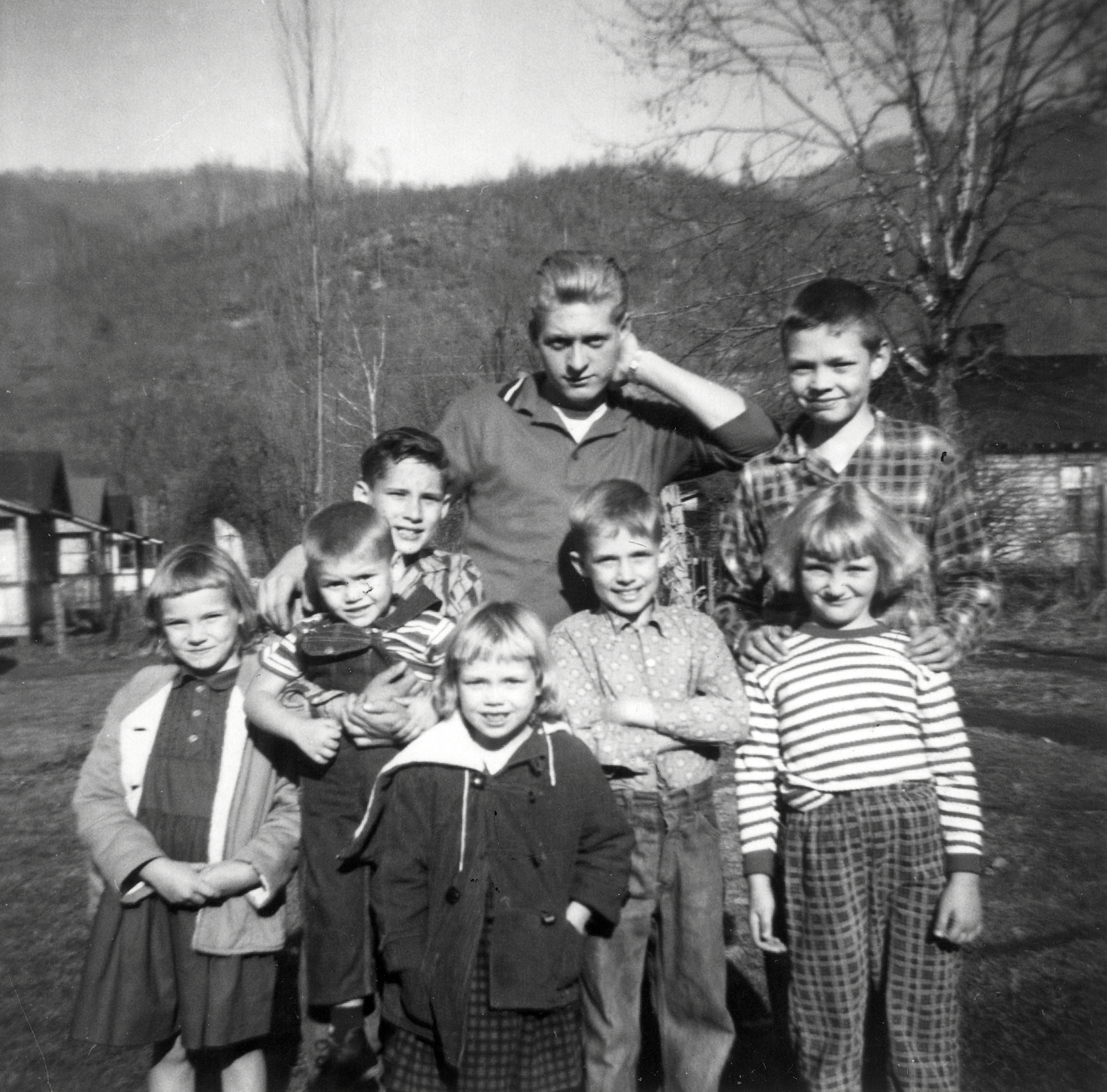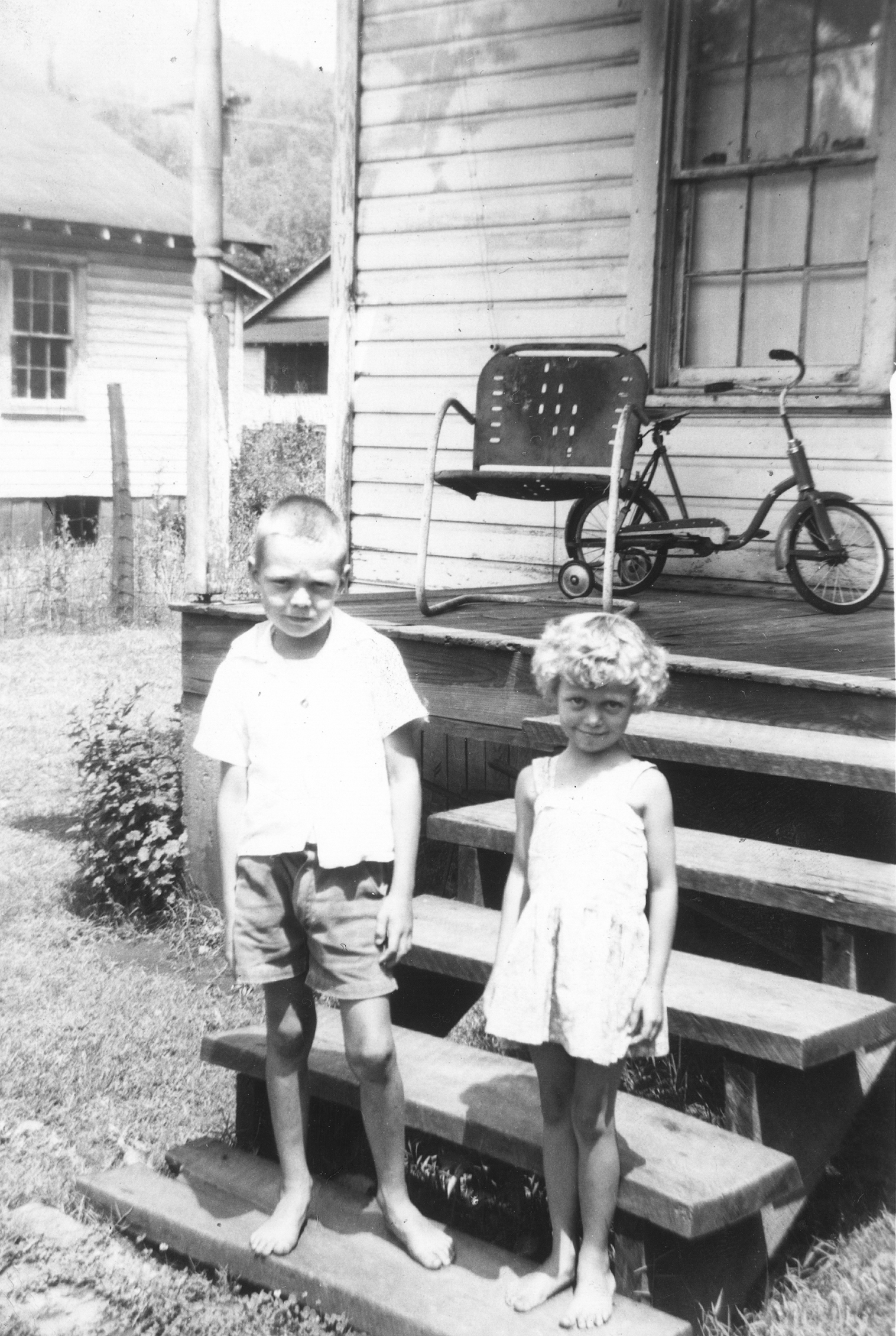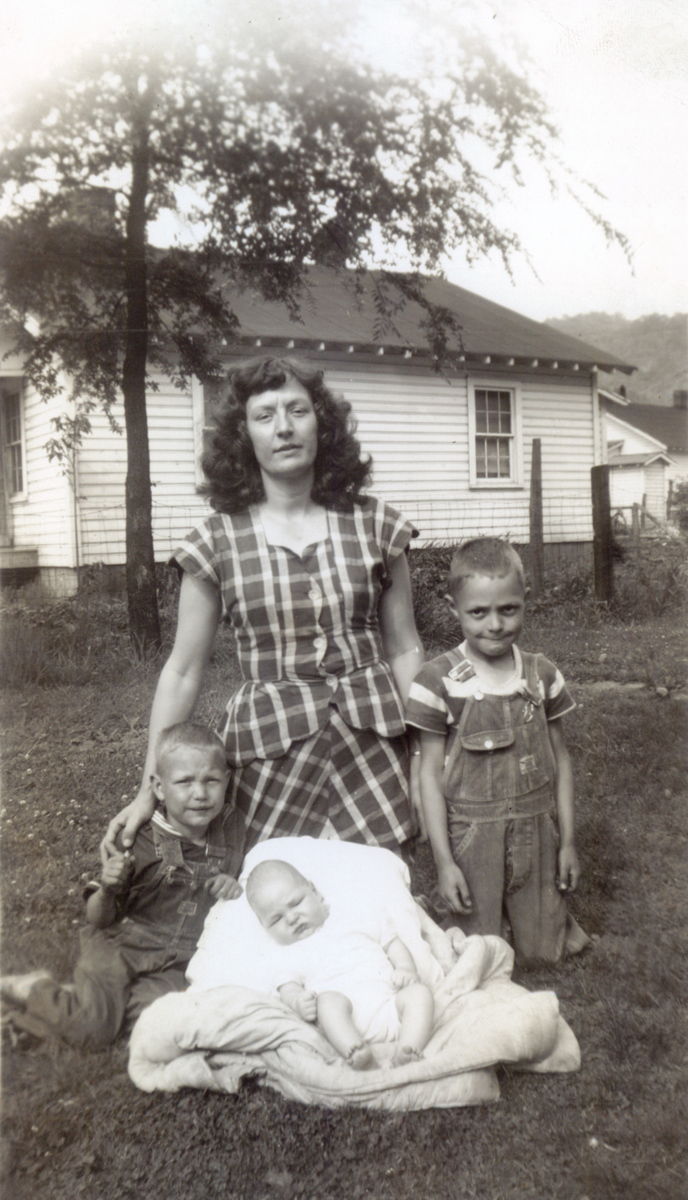Bruce grew up in the small mining camp of Insull, Harlan County, KY. The Camp was divided into old and new sections and had a grade school (1-6) but that closed in 1955 and he attended first grade at Blackstar which had grades 1-12. The new section was at the bottom of the old section, across the swing-bridge over Puckett's Creek. Insull had its own commissary where miners could spend their script they earned as wages, a bath house for the miners, a large tipple and a multiple railroad track system for bring in empty gons and removing gons loaded with different sized coal. Miners who were supervisors lived in two story houses, there were about 5-6 houses of this type. The mine was near the top of the mountain and coal was sent down to the tipple via an incline where cars were sent down and the coal was dumped into a large hopper. From there the coal was dumped from the bottom of the hopper on to a series of large metal plates that shook, each plate with one size of holes. As the coal moved from plate to plate, the coal would fall through their respective holes into another hopper over tracks where coal gons would run under the hopper and filled. There were 3-4 sets of tracks under the tipple for this plus the main tracks where the empty gons would be delivered. This movement of gons under the hoppers to be filled was done by gravity. Once filled the gons would feed down by gravity on its set of tracks and attached to another gon. This would continue until there was enough gons to be hauled off. The train engine would come in, attach to the first set of gons, move back out until it cleared the switch, throw the switch, and keep picking up all the gons and then back all the way out and move out of the hollow.
He attended grade schools at Blackstar, Blackmont, and Harmony.
Graduated from Bell County High School, East Pineville, Bell County, KY, 1967.
Received medical technology training at Beckley Appalachian Regional Hospital, Beckley, WVA (1971) and specialty in blood banking at Tri-Service Blood Bank Fellowship at Walter Reed Army Medical Center (1980).
Received a BS at Morehead State University (1971) and a MBA in Health Care Administration from National University (1983).
....................................................
BS, MBA, MT(ASCP) SBB
Captain, Medical Service Corps, United States Navy, Retired (CAPT, MSC, USN, Retired)
Captain Rutherford entered the United States Navy in October 1971 as a direct commissioned officer with the rank of Ensign. His duty stations included:
1971-1973, Laboratory Officer, U.S. Naval Hospital, Guam
1973-1976, Laboratory Officer, Naval Hospital, Port Hueneme, CA
1976-1977, Admin Officer; Naval Medical Research Unit #2 Detachment, Jakarta, Indonesia
1977-1979, Blood Donor Center Officer, National Naval Medical Center, Bethesda, MD
1979-1980, Student, Blood Bank Fellowship, Walter Reed Army Medical Center
1980-1984, Blood Donor Center Officer, Blood Bank Officer, Senior Laboratory Officer, Naval Medical Center, San Diego, CA
1984-1986, Director, Joint Blood Program Office, U. S. Pacific Command; Component
Command Blood Program Officer, Commander-in-Chief, Pacific Fleet; Area Joint
Blood Program Officer, Okinawa Area; and Blood Donor Center Officer,
U. S. Naval Hospital Okinawa, Japan
1986-1988, Senior Laboratory Officer, Naval Medical Center, Portsmouth, VA
1988-1990, Director, Ancillary Services, Naval Medical Center, Portsmouth, VA
1990-1995, Head, Navy Blood Program, Washington, D.C.
1995-1999, Director, Armed Services Blood Program, Falls Church, VA.
Fresh to the Navy and without any mentors to guide him, Captain Rutherford (then Ensign) was ordered to Guam which had not had a laboratory officer in over three years. He was on Guam in 1972 when President Nixon stopped over night for his trip to China. He was instrumental in expanding laboratory services at the U. S. Naval Hospital Guam to receive POWs from Viet Nam for which the hospital received a Meritorious Unit Commendation.
As the first Laboratory Officer at Naval Hospital, Port Hueneme, CA., this naval hospital's small laboratory was the first in its category to receive accreditation by the College of American Pathology and American Association of Blood Banks. He also served as Acting Personnel Officer for the hospital for six months prior to his transfer.
He was the first Medical Technologist/Administrative Officer assigned to the Naval Medical Research Unit #2, Jakarta Indonesia Detachment, to provide administrative controls and help in the research of tropical diseases (Typhoid Fever, Cholera, Shigellosis, Dengue Fever, Microfalariae, Lymphatic Filariasis, etc.).
At San Diego (the Navy's largest medical facility), he first served as the Blood Donor Center Officer, then Senior Blood Bank Officer and then Senior Laboratory Officer.
With problems at USPACOM Blood Program Office, CAPT Rutherford was ordered in to improve the program and to move it forward. He served as the U. S. Pacific Command's Unified Command's fourth Joint Blood Program Officer as well as the Component Command Blood Program Officer, Commander-in-Chief, Pacific Fleet; Area Joint Blood Program Officer, Okinawa Area; and Blood Donor Center Officer, U. S. Naval Hospital Okinawa; responsible for logistical blood support for the 64 million square mile Pacific theater, including any conflict on the Korean Peninsula; directed Pacific wide testing of the military's blood support operations for Korean during the '85 and '86 TEAM SPIRIT exercises in Korea, including CDS bundle drops from a C-141 and a Low Altitude Parachute Extraction System slide from the back of a C-130; established the first HIV testing program for Navy, Marine Corps and Army personnel stationed in the Pacific and his QA program was used by the Navy to establish force wide screening; received approval and set in motion the building of a new facility with a large (20,000 units) frozen blood repository; and initiated the FDA licensing of the facility. For the U.S. Naval Hospital, Okinawa, he also served at times as Acting Executive Officer and Acting Director for Administration.
With problems at Portsmouth Naval Medical Center (Navy's second largest medical facility), he was ordered in as the Senior Laboratory Officer to provide leadership, improve morale, and improve the overall operations of the laboratory services. Having accomplished this task, eighteen months later he was chosen as the first full-time Director of Ancillary Services (Pharmacy, Radiology, Laboratory, Physical Therapy, Occupational Therapy, and Social Services) where he funded the hospital's drive-thru pharmacy and satellite pharmacy at the Navy Yard's exchange along with moving a STAT laboratory next to the Emergency Room. Along with being the Director of Ancillary Services, he was also chosen to serve as the Administrative Assistant to the Medical Center's Executive Officer.
In 1990 he was selected as the seventh Director, Navy Blood Program at the Navy's Bureau of Medicine and Surgery in Washington, DC and directed the day to day operations of the Program for two Surgeons General of the Navy as well as managing the Navy's Food and Drug Administration (FDA) license. During Desert Storm/Shield he directed the Blood Program from 0600-1530 hrs and then stood duty from 1530-2300 hrs. as the PM Watch Supervisor for Navy Medical Readiness for the deployment of medical assets. Under his watch all Navy blood donor centers and manufactured blood products were licensed by the FDA, he expanded the frozen blood program, streamlined the prepositioning of blood bank war supplies, and developed a HIV Lookback Program highly regarded and recognized by the DoD Inspector General including Risk Management referrals. Realizing the need for better communication between his office and the Navy blood facilities, he published a Navy Newsletter every month providing insight into the day-to-day operations and well as future direction of the Navy and Armed Services Blood Program. In addition to his primary duties, he also served as Acting Director, Navy Medical Readiness Division from June 1992 to March 1993 during which medical assets were deployed in support of Hurricane Andrew, Operation Restore Hope (Somalia), Operation Southern Watch (Persian Gulf), Operation Provide Comfort (Adriatic), and Typhoons Inika (Hawaii) and Omar (Guam). Working with Captain Valarie at the Navy Blood Research Laboratory in Boston, they submitted data for Fibrinogen and Factor Eight levels for Fresh Frozen Plasma (FFP) for storage for ten years at -80 degrees centigrade and obtained an FDA license for all Navy FFP products. A strong supporter and leader in the effort to change the FDA's regulations requiring the use of color in blood bank labels, he wrote a manual in 1993 that was used to write computer code and designs for a blood bank print-on-demand labeling system (HEMATRAX) that was subsequently approved by the FDA and became the benchmark for blood banking worldwide. The Navy Blood Program became the first U. S. blood program fully licensed by the FDA to use the non-color print-on-demand labeling system. He directed the development of and then instituted a Good Manufacturing Practices training program for Navy Blood Program personnel which was later expanded to include Army and Air Force Blood Programs' personnel.
In 1995 Captain Rutherford was selected by The Assistant Secretary of Defense for Health Affairs to fill the position as the twelfth Director of the Armed Services Blood Program. He coordinated the blood programs of the three services (Army, Navy and Air Force) and the Unified Commands and was ultimately responsible for all the military's peacetime, wartime, ongoing operations, and special operations blood requirements and overall policies and procedures. For blood requirements for ongoing operations and special operations, he provided coordinated logistical support to the Joint Chiefs of Staff (Medical Readiness Division). He continued the automation of the Defense Blood Standard System into war zone fields of operation, primarily responsible for funding and deployment of the system, and moved it into a Windows based system. He was instrumental in supporting funding and research of Combat Casualty Care areas leading to worldwide use of hemostatic IV fluids and a hemostatic bandage. He obtained funding and established the first ASBP homepage to facilitate communications between the Program Office and other entities within the military and civilian blood communities.
He served as a Department of Defense liaison to the Health and Human Services' Blood Safety and Availability Committee, the Institute of Medicine's Blood Safety Forum, and the American Association of Blood Banks' Standards Committee and their Transfusion Transmitted Disease Committee.
His awards included: Defense Superior Service Medal, Legion of Merit, Meritorious Service Medal, Army Commendation Medal, Navy Achievement Medal (w/Star), Meritorious Unit Commendation, Overseas Service Ribbon (w/Star), National Defense Service Medal and Office of the Secretary of Defense Badge.
In 2013 he was awarded the Armed Services Blood Program's Lifetime Achievement Award.
2019 established The Captain Bruce D. Rutherford Endowment Scholarship at Morehead State University for students in need from Harlan and Bell counties in Eastern Kentucky.
2022 established The William Ray "Billy" Cornett Memorial Scholarship at Morehead State Scholarship for students in need from Menifee County, Kentucky.
2023-24 established the Jessica Kelly Hughes Memorial Scholarship at Coastal Carolina University.
Bruce was an avid contributor to Find A Grave, spending hours entering memorials, walking graveyards/cemeteries in his beloved Kentucky and Tennessee, taking inventory and photographs and entering them into the system. Every memorial was special to him, researching as much information as he could find so he could make the memorial "live" and tell a story about the individual.
Bruce grew up in the small mining camp of Insull, Harlan County, KY. The Camp was divided into old and new sections and had a grade school (1-6) but that closed in 1955 and he attended first grade at Blackstar which had grades 1-12. The new section was at the bottom of the old section, across the swing-bridge over Puckett's Creek. Insull had its own commissary where miners could spend their script they earned as wages, a bath house for the miners, a large tipple and a multiple railroad track system for bring in empty gons and removing gons loaded with different sized coal. Miners who were supervisors lived in two story houses, there were about 5-6 houses of this type. The mine was near the top of the mountain and coal was sent down to the tipple via an incline where cars were sent down and the coal was dumped into a large hopper. From there the coal was dumped from the bottom of the hopper on to a series of large metal plates that shook, each plate with one size of holes. As the coal moved from plate to plate, the coal would fall through their respective holes into another hopper over tracks where coal gons would run under the hopper and filled. There were 3-4 sets of tracks under the tipple for this plus the main tracks where the empty gons would be delivered. This movement of gons under the hoppers to be filled was done by gravity. Once filled the gons would feed down by gravity on its set of tracks and attached to another gon. This would continue until there was enough gons to be hauled off. The train engine would come in, attach to the first set of gons, move back out until it cleared the switch, throw the switch, and keep picking up all the gons and then back all the way out and move out of the hollow.
He attended grade schools at Blackstar, Blackmont, and Harmony.
Graduated from Bell County High School, East Pineville, Bell County, KY, 1967.
Received medical technology training at Beckley Appalachian Regional Hospital, Beckley, WVA (1971) and specialty in blood banking at Tri-Service Blood Bank Fellowship at Walter Reed Army Medical Center (1980).
Received a BS at Morehead State University (1971) and a MBA in Health Care Administration from National University (1983).
....................................................
BS, MBA, MT(ASCP) SBB
Captain, Medical Service Corps, United States Navy, Retired (CAPT, MSC, USN, Retired)
Captain Rutherford entered the United States Navy in October 1971 as a direct commissioned officer with the rank of Ensign. His duty stations included:
1971-1973, Laboratory Officer, U.S. Naval Hospital, Guam
1973-1976, Laboratory Officer, Naval Hospital, Port Hueneme, CA
1976-1977, Admin Officer; Naval Medical Research Unit #2 Detachment, Jakarta, Indonesia
1977-1979, Blood Donor Center Officer, National Naval Medical Center, Bethesda, MD
1979-1980, Student, Blood Bank Fellowship, Walter Reed Army Medical Center
1980-1984, Blood Donor Center Officer, Blood Bank Officer, Senior Laboratory Officer, Naval Medical Center, San Diego, CA
1984-1986, Director, Joint Blood Program Office, U. S. Pacific Command; Component
Command Blood Program Officer, Commander-in-Chief, Pacific Fleet; Area Joint
Blood Program Officer, Okinawa Area; and Blood Donor Center Officer,
U. S. Naval Hospital Okinawa, Japan
1986-1988, Senior Laboratory Officer, Naval Medical Center, Portsmouth, VA
1988-1990, Director, Ancillary Services, Naval Medical Center, Portsmouth, VA
1990-1995, Head, Navy Blood Program, Washington, D.C.
1995-1999, Director, Armed Services Blood Program, Falls Church, VA.
Fresh to the Navy and without any mentors to guide him, Captain Rutherford (then Ensign) was ordered to Guam which had not had a laboratory officer in over three years. He was on Guam in 1972 when President Nixon stopped over night for his trip to China. He was instrumental in expanding laboratory services at the U. S. Naval Hospital Guam to receive POWs from Viet Nam for which the hospital received a Meritorious Unit Commendation.
As the first Laboratory Officer at Naval Hospital, Port Hueneme, CA., this naval hospital's small laboratory was the first in its category to receive accreditation by the College of American Pathology and American Association of Blood Banks. He also served as Acting Personnel Officer for the hospital for six months prior to his transfer.
He was the first Medical Technologist/Administrative Officer assigned to the Naval Medical Research Unit #2, Jakarta Indonesia Detachment, to provide administrative controls and help in the research of tropical diseases (Typhoid Fever, Cholera, Shigellosis, Dengue Fever, Microfalariae, Lymphatic Filariasis, etc.).
At San Diego (the Navy's largest medical facility), he first served as the Blood Donor Center Officer, then Senior Blood Bank Officer and then Senior Laboratory Officer.
With problems at USPACOM Blood Program Office, CAPT Rutherford was ordered in to improve the program and to move it forward. He served as the U. S. Pacific Command's Unified Command's fourth Joint Blood Program Officer as well as the Component Command Blood Program Officer, Commander-in-Chief, Pacific Fleet; Area Joint Blood Program Officer, Okinawa Area; and Blood Donor Center Officer, U. S. Naval Hospital Okinawa; responsible for logistical blood support for the 64 million square mile Pacific theater, including any conflict on the Korean Peninsula; directed Pacific wide testing of the military's blood support operations for Korean during the '85 and '86 TEAM SPIRIT exercises in Korea, including CDS bundle drops from a C-141 and a Low Altitude Parachute Extraction System slide from the back of a C-130; established the first HIV testing program for Navy, Marine Corps and Army personnel stationed in the Pacific and his QA program was used by the Navy to establish force wide screening; received approval and set in motion the building of a new facility with a large (20,000 units) frozen blood repository; and initiated the FDA licensing of the facility. For the U.S. Naval Hospital, Okinawa, he also served at times as Acting Executive Officer and Acting Director for Administration.
With problems at Portsmouth Naval Medical Center (Navy's second largest medical facility), he was ordered in as the Senior Laboratory Officer to provide leadership, improve morale, and improve the overall operations of the laboratory services. Having accomplished this task, eighteen months later he was chosen as the first full-time Director of Ancillary Services (Pharmacy, Radiology, Laboratory, Physical Therapy, Occupational Therapy, and Social Services) where he funded the hospital's drive-thru pharmacy and satellite pharmacy at the Navy Yard's exchange along with moving a STAT laboratory next to the Emergency Room. Along with being the Director of Ancillary Services, he was also chosen to serve as the Administrative Assistant to the Medical Center's Executive Officer.
In 1990 he was selected as the seventh Director, Navy Blood Program at the Navy's Bureau of Medicine and Surgery in Washington, DC and directed the day to day operations of the Program for two Surgeons General of the Navy as well as managing the Navy's Food and Drug Administration (FDA) license. During Desert Storm/Shield he directed the Blood Program from 0600-1530 hrs and then stood duty from 1530-2300 hrs. as the PM Watch Supervisor for Navy Medical Readiness for the deployment of medical assets. Under his watch all Navy blood donor centers and manufactured blood products were licensed by the FDA, he expanded the frozen blood program, streamlined the prepositioning of blood bank war supplies, and developed a HIV Lookback Program highly regarded and recognized by the DoD Inspector General including Risk Management referrals. Realizing the need for better communication between his office and the Navy blood facilities, he published a Navy Newsletter every month providing insight into the day-to-day operations and well as future direction of the Navy and Armed Services Blood Program. In addition to his primary duties, he also served as Acting Director, Navy Medical Readiness Division from June 1992 to March 1993 during which medical assets were deployed in support of Hurricane Andrew, Operation Restore Hope (Somalia), Operation Southern Watch (Persian Gulf), Operation Provide Comfort (Adriatic), and Typhoons Inika (Hawaii) and Omar (Guam). Working with Captain Valarie at the Navy Blood Research Laboratory in Boston, they submitted data for Fibrinogen and Factor Eight levels for Fresh Frozen Plasma (FFP) for storage for ten years at -80 degrees centigrade and obtained an FDA license for all Navy FFP products. A strong supporter and leader in the effort to change the FDA's regulations requiring the use of color in blood bank labels, he wrote a manual in 1993 that was used to write computer code and designs for a blood bank print-on-demand labeling system (HEMATRAX) that was subsequently approved by the FDA and became the benchmark for blood banking worldwide. The Navy Blood Program became the first U. S. blood program fully licensed by the FDA to use the non-color print-on-demand labeling system. He directed the development of and then instituted a Good Manufacturing Practices training program for Navy Blood Program personnel which was later expanded to include Army and Air Force Blood Programs' personnel.
In 1995 Captain Rutherford was selected by The Assistant Secretary of Defense for Health Affairs to fill the position as the twelfth Director of the Armed Services Blood Program. He coordinated the blood programs of the three services (Army, Navy and Air Force) and the Unified Commands and was ultimately responsible for all the military's peacetime, wartime, ongoing operations, and special operations blood requirements and overall policies and procedures. For blood requirements for ongoing operations and special operations, he provided coordinated logistical support to the Joint Chiefs of Staff (Medical Readiness Division). He continued the automation of the Defense Blood Standard System into war zone fields of operation, primarily responsible for funding and deployment of the system, and moved it into a Windows based system. He was instrumental in supporting funding and research of Combat Casualty Care areas leading to worldwide use of hemostatic IV fluids and a hemostatic bandage. He obtained funding and established the first ASBP homepage to facilitate communications between the Program Office and other entities within the military and civilian blood communities.
He served as a Department of Defense liaison to the Health and Human Services' Blood Safety and Availability Committee, the Institute of Medicine's Blood Safety Forum, and the American Association of Blood Banks' Standards Committee and their Transfusion Transmitted Disease Committee.
His awards included: Defense Superior Service Medal, Legion of Merit, Meritorious Service Medal, Army Commendation Medal, Navy Achievement Medal (w/Star), Meritorious Unit Commendation, Overseas Service Ribbon (w/Star), National Defense Service Medal and Office of the Secretary of Defense Badge.
In 2013 he was awarded the Armed Services Blood Program's Lifetime Achievement Award.
2019 established The Captain Bruce D. Rutherford Endowment Scholarship at Morehead State University for students in need from Harlan and Bell counties in Eastern Kentucky.
2022 established The William Ray "Billy" Cornett Memorial Scholarship at Morehead State Scholarship for students in need from Menifee County, Kentucky.
2023-24 established the Jessica Kelly Hughes Memorial Scholarship at Coastal Carolina University.
Bruce was an avid contributor to Find A Grave, spending hours entering memorials, walking graveyards/cemeteries in his beloved Kentucky and Tennessee, taking inventory and photographs and entering them into the system. Every memorial was special to him, researching as much information as he could find so he could make the memorial "live" and tell a story about the individual.
Inscription
FAIR WINDS AND FOLLOWING SEAS
